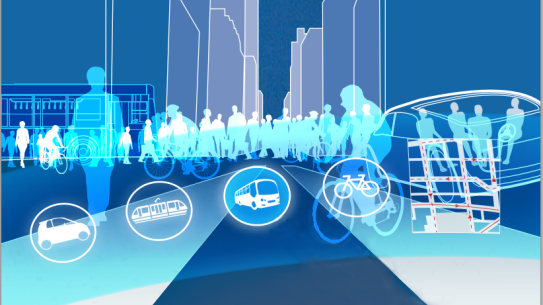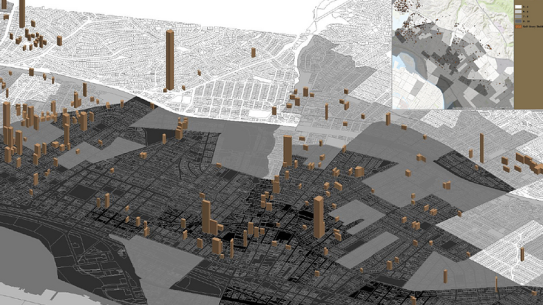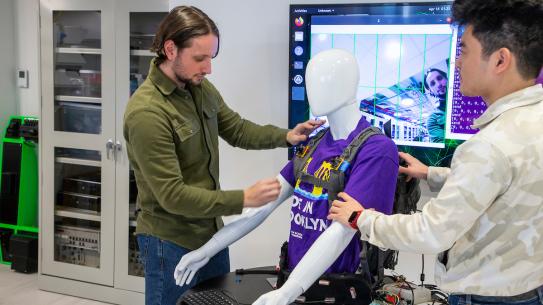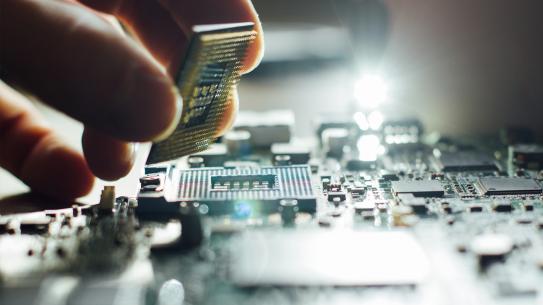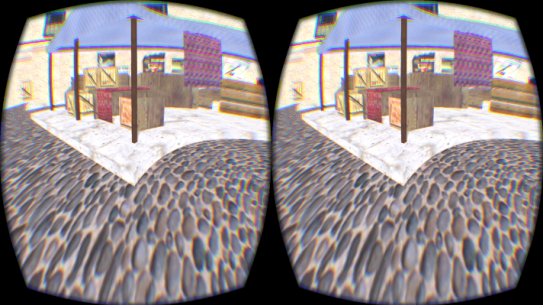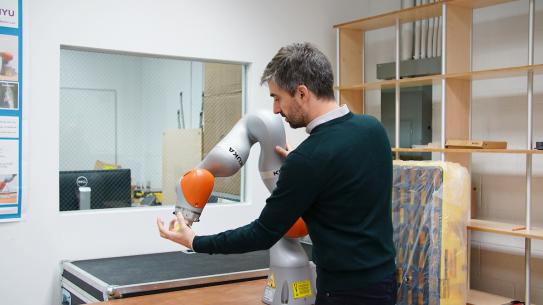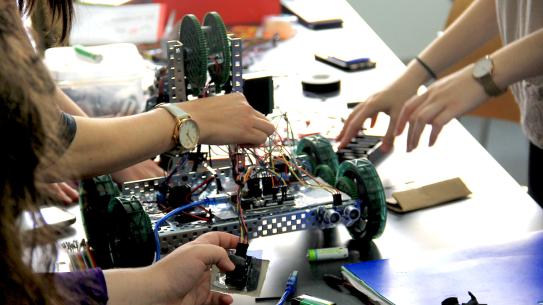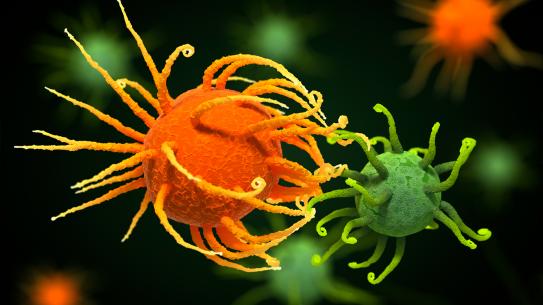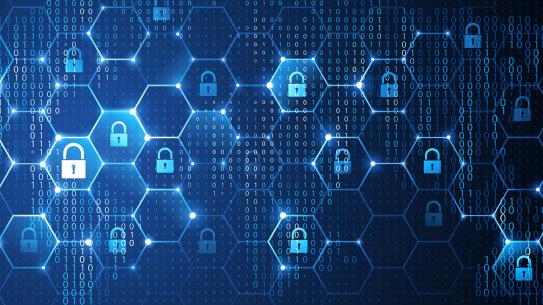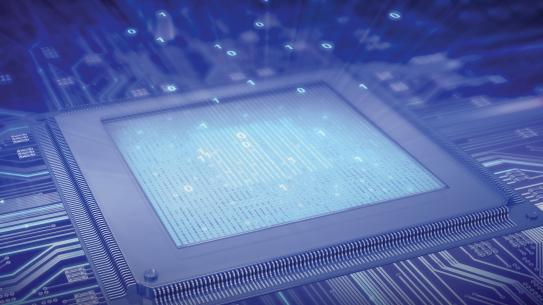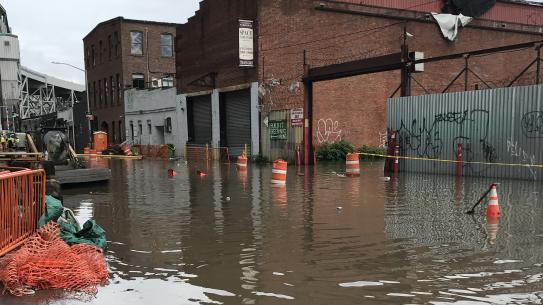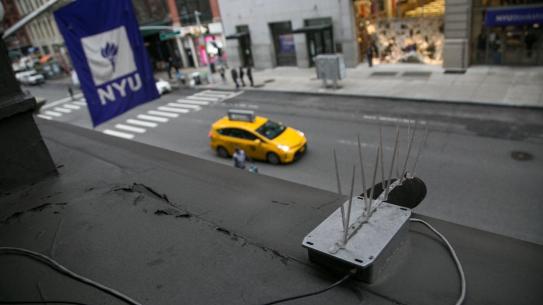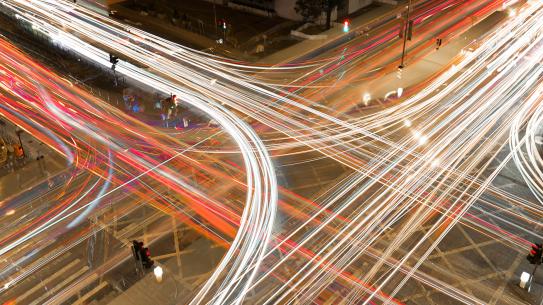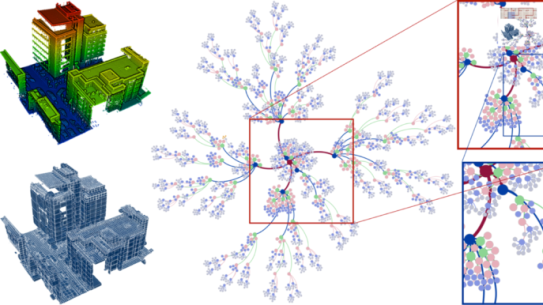Labs and Groups
We are home to dozens of research labs and groups, where engineering researchers are bridging disciplines in state-of-the-art facilities.
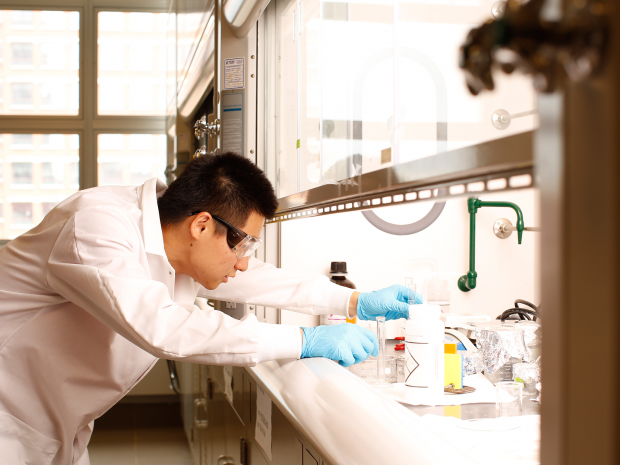
Advanced Ophthalmic Imaging Laboratory (AOIL)
The AOIL consists of a team of ophthalmologists, engineers, software specialists, statisticians, and trainees that focus primarily on the study of glaucoma, a leading cause of blindness in the world. The groups of Profs. Schuman, Wollstein and Ishikawa develop advanced imaging tools to detect this disease, monitor its progression, and investigate its pathogenesis.
Agile Robotics and Perception Lab
ARPL performs fundamental and applied research in robot autonomy. The lab develops agile autonomous drones that can navigate on their own using only onboard sensors without relying on maps, GPS or motion capture systems.
AI4CE Lab
The AI4CE Lab works to advance fundamental automation and intelligence technologies, to enable their use in civil and mechanical engineering applications.
Algorithms and Foundations Group
The Algorithms and Foundations Group at NYU's Tandon School of Engineering is composed of researchers interested in applying mathematical and theoretical tools to a variety of disciplines in computer science. We study problems in machine learning, geometry, computational biology, computational mathematics, and beyond.
Angelaki Lab
The systems and computational neuroscience laboratory of Professor Dora Angelaki focuses on how the brain generates perception and cognition. Her group studies how multi-sensory signals flow dynamically across brain areas, how causal inference is implemented in the brain, how beliefs propagate through the network, and how internal states modulate this information flow.
Applied Dynamics and Optimization Laboratory
We aim to establish mathematical models, quantitative criteria, and algorithmic/computational foundations toward their implementations in robotics (for design and control), biomechanical systems (for prediction and analysis), and their intersections such as lower-body wearable robots. Our current research topics include energetics of dynamic systems, legged balance and gait stability, and integration of dynamics/control with numerical optimization.
Applied Micro-Bioengineering Laboratory (AMBL)
Taking advantage of state-of-art nanotechnologies and fabricating fascinating functional biomaterials and integrated biosystems, the Professor Weiqiang Chen’s laboratory addresses numerous important problems in fundamental biology as well as clinical applications in disease diagnosis and treatment.
Bio-interfacial Engineering and Diagnostics Lab
Levicky Group — The Bio-interfacial Engineering and Diagnostics Group’s research focuses on quantitative characterization of biomolecular interactions, with technological connections to diagnostics for medical and fundamental biology applications. The group seeks to dissect the fundamental equilibrium and kinetic aspects of biomolecular reactions at surfaces and in solution, elucidate the role played by the molecular organization, and apply this understanding to advance bioanalytical technologies.
Boeke Lab
The laboratory of Professor Jef Boeke is well known for foundational work on mechanistic and genomic aspects of retro-transposition in both yeast and mammalian systems. After more than three decades, they continue to scrutinize their favorite genomic parasites. In addition, the Boeke lab is heavily involved in the development of novel technologies in genetics, genomics and synthetic biology.
Brooklyn Application, Architecture, and Hardware Lab (BAAHL)
Led by Prof. Brandon Reagen, our research group specializes in computer hardware design, with a primary goal of making privacy-preserving computation practical.
We also focus on optimizing machine learning systems for private computation. With a strong emphasis on energy-efficiency and security, our work aims to accelerate secure computation and enable privacy-preserving machine learning.
Building Informatics and Visualization Lab (BiLab)
The Building Informatics and Visualization Lab (biLAB) is part of the Department of Civil and Urban Engineering at the NYU School of Engineering. It focuses on understanding the operational challenges associated with construction and operation of facilities and infrastructure systems in urban settings.
BUILT @ NYU
The Behavioral Urban Informatics, Logistics, and Transport Lab conducts research in the area of transportation systems design and modeling. Typical products of this lab may include dynamic operating policies for flexible transport services, a parking pricing and information system for travelers, or a fleet routing algorithm for autonomous vehicles or other cyber-physical transportation systems.
Cell Programming and Genome Engineering Lab
David Truong’s lab uses principles from synthetic and systems biology, cell fate reprogramming, epigenetics, and immunology. He and his team perform large-scale genome engineering in human and mouse stem cells towards cell therapies and regenerative medicine. The group currently focuses on developing programmable off-the-shelf dendritic cells from human iPSCs as a cancer immunotherapy platform. They are also building universal “personalized” iPSCs as an off-the-shelf cell for making living therapies.
Center for Advanced Imaging Innovation and Research
Professor Dan Sodickson’s research primarily addressed the development of new techniques for biomedical imaging to improve human health. He leads a multidisciplinary team that develops new methods for rapid continuous imaging, taking advantage of recent developments in parallel imaging, compressed sensing, and artificial intelligence. This work extends to clinical applications of MRI, PET and CT.
Center for Advanced Technology in Telecommunications (CATT)
CATT promotes industry-university collaborative research and development in these areas: wireless and personal communications networks and devices, secure information technologies, and media and network applications/services.
Center for Urban Science + Progress (CUSP)
The Center for Urban Science and Progress (CUSP) is an interdisciplinary research center dedicated to the application of science, technology, engineering, and mathematics in the service of urban communities across the globe. Using New York City as our laboratory and classroom, we strive to develop novel data- and technology-driven solutions for complex urban problems.
Chunara Lab
The overarching goal of our research is to develop the principles needed to incorporate unstructured, Internet and mobile data into a better understanding of population-level health. We primarily develop computational methods across data mining, natural language processing, and machine learning to generate features for spatio-temporal population-level public health models.
Clinical Biophotonics Laboratory
Professor Andreas Hielscher’s team focuses on developing clinically relevant optical tomographic imaging systems. They apply these devices and wearable electronics to the diagnosis and treatment of various diseases, such as breast cancer, arthritis, peripheral artery disease, diabetic foot syndrome, and real-time monitoring of brain activities.
CommIT Group
The Communication and Information Theory (CommIT) Group at New York University is led by Professor Elza Erkip. They are interested in the theoretical foundations of networks, including wireless and social networks.
Composite Materials and Mechanics Laboratory
CMML focuses on research related to lightweight highly damage tolerant materials and aims at understanding the fundamental role of porosity in materials. The specialty of the lab is in the area of hollow particle filled composites called syntactic foams and in dynamic characterization of materials. CMML has been working on polymer and metal matrix syntactic foams for civilian and military automotive applications that are exposed to dynamic loading conditions. The other areas of interest to CMML are additive manufacturing and sensors for structural health monitoring.
Computational Medicine Laboratory
Professor Rose Faghih group develops biomedical signal processing and control algorithms for human-technology interactions and monitoring. These state-of-the-art tools are employed for prognosis, diagnosis, and treatment of pathological conditions related to neuro-endocrine and neuro-psychiatric disorders.
Computational Neuroscience, Neuroengineering, and Neuropsychiatry Laboratory (CN3)
The research in Professor Sage Chen’s lab aims to find solutions for real-time brain-machine interfaces, pain management, and psychiatric disorders. Developing a better understanding of memory and sleep is another goal. To accomplish all this, they advance and integrate the fields of computational neuroscience, neural engineering, and machine learning.
Connected Cities for Smart Mobility toward Accessible and Resilient Transportation (C2SMART)
C2SMART is a U.S. Department of Transportation Tier 1 University Transportation Center for research, education, workforce development, and technology transfer activities. Rather than just focusing on developing technologies to make a city smarter, C2SMART is dedicated to a related critical step: how to connect these disparate technologies with cities of different population and infrastructure scales and different systems of systems.
Control and Network (CAN) Lab
The CAN Lab, led by Professor Zhong-Ping Jiang, develops fundamental principles and tools for the stability analysis and control of nonlinear dynamical networks, with applications to information, mechanical, and biological systems.
Control/Robotics Research Laboratory (CRRL)
CCRL conducts research projects on unmanned vehicles, autonomy and navigation, control systems, cyber-security, and machine learning.
Craniomaxillofacial Orthopedic Biomaterials Regenerative Applications Lab
Professor Lukasz Witek’s research group performs in vivo and in vitro evaluations of a wide range of (bio)materials that can be used as implants for dental and orthopedic applications. A special focus is on 3D printing of bio-ceramic materials for tissue regeneration.
CUSP Urban Observatory (CUSP-UO)
Through the novel use of observational and analytical techniques, the Urban Observatory at the Center for Urban Science + Progress (CUSP-UO) studies the complex interactions between the physical, natural, and human components of the city as a coherent, definable system with the goal of enhancing public well-being, city operations, and future urban plans.
Cybersecurity for Democracy
Cybersecurity for Democracy is a research-based, nonpartisan, and independent effort to expose online threats to our social fabric — and recommend how to counter them. We are part of the Center for Cybersecurity at the NYU Tandon School of Engineering.
Davoli Lab
What are the causes and consequences of genomic copy number alterations (i.e. aneuploidy) in cancer and how does this affect patients’ response to therapy, especially immuno-therapy? These are among the main questions Prof. Teresa Davoli’s lab is interested in. To answer these questions, they utilize a variety of experimental and computational approaches, from large- scale genetic screens in human cells, to prediction of survival in cancer patients.
DICE (Data, Intelligence, and Computation in Engineering) Lab
The Data, Intelligence and Computation in Engineering (DICE) Lab is led by Assistant Professor Chinmay Hegde and focuses on theoretical and applied aspects deep learning and machine learning.
Disaster Risk Analysis Lab
Natural catastrophes are steadily increasing in severity and frequency as cities become larger, denser, and more interconnected. The Disaster Risk Analysis Lab's goal is to extend the limits of what is feasible with catastrophe modeling and collaborate synergistically with researchers within and outside civil engineering to leverage new technologies to increase post-disaster power accessibility, provide more effective disaster emergency response, and reduce risk trajectories in our cities.
Dynamical Systems Laboratory (DSL)
Professor Maurizio Porfiri’s group conducts multidisciplinary research in the theory and application of dynamical systems, motivated by the objectives of advancing engineering science and improving society. Their theoretical expertise is in controls, networks, nonlinear dynamics, and time-series, while our application domain is in modeling and analysis of physical, social, and technical systems.
EnSuRe Research Group
Our research focuses on computer hardware, including electronic design automation (EDA) and micro-architectural solutions for energy-efficient (En), secure (Su), and reliable (Re) computing.
Fire Research Group
Researchers at the Fire Research Group work on an online, scenario-based simulation training program for firefighters. ALIVE (Advanced Learning through Integrated Visual Environments) is a decades-long effort to bridge the information gap between research and real-life firefighting.
Game Innovation Lab
The Game Innovation Lab brings together faculty and students from the School of Engineering and the greater NYU community doing research focused on games as an innovation challenge. The Lab's emphasis is on the technical / engineering / science side of games and simulations. Sample projects include user interface innovation (sensor-based tracking, multi-touch), network and video quality research, and research on games for learning.
Gerig Lab
Using advances in computer vision and machine learning, Professor Guido Gerig’s team develops image analysis methodologies related to segmentation, registration, atlas building, shape analysis, and image statistics. Collaboratively with clinical research, this work is driven by medical problems covering research in autism, Down's syndrome, eye diseases, Huntington's disease, and musculoskeletal disorders.
Hartman Research Lab
The Hartman Research Laboratory investigates the kinetics of chemical reactions and the design of the reactors in which they take place. Catalysis and reaction engineering is at the heart of virtually every process or system in which a chemical transformation occurs.
High Speed Networking Lab
Our research is concentrated on developing complete solutions for data center networks, software-defined networks, high-speed switching and routing, network security and traffic measurement problems.
Hudson Lab
Todd Hudson is a computational neuroscientist whose research focuses on modeling sensory and motor systems, particularly eye and arm movements in healthy and disease states. He received his training at the Clarence Graham Memorial Laboratory of Visual Science at Columbia University, and co-founded Tactile Navigation Tools, LLC, a company that develops navigation aids for the visually impaired.
Hybrid Nanomaterials Lab
Sahu Group — Our research investigates the transport phenomena in new and novel classes of nanostructured hybrid materials that have promise for optoelectronic and thermoelectric energy conversion. Our group has expertise in colloidal synthesis, advanced characterization, and device implementation of such materials.
IDM XR LAB
Located in the Brooklyn Navy Yard, the IDM XR Lab provides access to the latest XR equipment and informational workshops and tutorials.
Immersive Computing Lab
The Immersive Computing Lab at NYU Tandon School of Engineering conducts cutting edge research that spans the fields of computer graphics, physics, and computational cognition, with the goal of creating unprecedented virtual and augmented reality systems to revolutionize urban life. Our research directions include novel multimodal/low-latency/immersive interaction devices, bio-physically inspired wearable displays, perception-aware VR/AR, and beyond.
Integrated BioElectronics Laboratory
Professor Sohmyung Ha’s lab aims at advancing the engineering and applications of silicon integrated technology interfacing with biology. This is approached in a variety of forms, ranging from implantable biomedical devices to unobtrusive wearable sensors.
International Center for Enterprise Preparedness (INTERCEP)
INTERCEP is the first academic center dedicated to organizational resilience and agility. The center maintains a global outreach with a special focus on multi-party collaboration including business-to-business and public-private partnerships. Acknowledging that "risk and reward" are at the core of all undertakings in both the public and private sectors, the Center focuses on the development of strategies to most effectively address uncertainty so as to achieve targeted objectives — in essence addressing "risks" to achieve "rewards".
Kirsch Lab
The ultimate goal of Professor Kirsch’s research is to define novel therapeutic targets for the treatment of osteoarthritis and other joint diseases and injuries. To this end the laboratory studies mechanisms involved in the regulation of cartilage homeostasis, maintenance and pathology. In addition, research is performed on how cells and the joint environment interact.
Laboratory for Advanced Neuroengineering and Translational Medicine
Professor Khalil Ramadi and his team develop innovative approaches for the modulation of neural activity throughout the body. The goal is to come up with novel therapies for neurologic, metabolic, and immune disorders. They combine mechanical, electrical, materials, and bio-engineering toolkits in the design of minimally invasive technologies.
Laboratory for Agile and Resilient Complex Systems
Our goal is to develop new control and game-theoretic tools for designing agile and resilient control for smart energy systems, communication networks, secure cyber-physical systems, and human-in-the-loop systems.
Laboratory for Biomechanics, Mechanobiology & Regenerative Medicine
Professor Alesha Castillo and her team study the interactions between mechanobiological cues and musculoskeletal systems with the long-term goal of developing novel biophysical, pharmaceutical, and stem cell-based interventions to improve musculoskeletal health
Laboratory for Living Interfaces
At the Laboratory for Living Interfaces we study the interaction of organisms and their environment through scientific and design enquiries. Through experimental practice, we aim to understand how the design decisions of architects, city planners, and material scientists affect the ubiquitous living component of the spaces we inhabit: the environmental microbiome.
Laboratory for Personalized Immunotherapies
Personalized immunotherapies involving CAR T cells, TCRs and BiTEs, have revolutionized the treatment of cancer. They provide in cures in subsets of cancer patients, yet remain ineffective for the majority of patients. Prof. Mark Yarmarkovich aims to expand the use of curative immunotherapies. To this end, his group develops and employ technologies at the intersection of genomics, proteomics, immunology, antibody engineering and computational biology.
Laboratory of Computational Multiomics
Professor Ruggles’ laboratory focuses on understanding human health and biology using data science, data visualization, and predictive modeling. A primary goal of this research is to analyze and integrate diverse data modalities, including bulk and single-cell sequencing, phospho- and global- proteomics, metagenomics, flow cytometry, imaging, and clinical data. These multi-omic methods are used to better understand cancer, heart diseases, and other disorders.
Laboratory of Computational Proteomics
Prof. David Fenyö’s uses proteomic approaches to develop methods to identify, characterize, and quantify proteins important for various cellular processes. His efforts to integrate data from multiple technologies - including mass spectrometry, sequencing, and microscopy - have provided a wide array of powerful tools to discover and verify biomarkers and therapeutic targets in cancer.
Lionnet Lab
To respond to a changing environment, cells have to express the right genes at the right time. Professor Timothy Lionnet’s lab tries to understand how exactly this is achieved and how robust responses emerge from random molecular events. Getting insights into these biomolecular processes will ultimately provide new tools to tackle, for example, wound healing, cancer, and many other diseases.
Machines in Motion
We try to understand the fundamental principles for robot locomotion and manipulation that will endow robots with the robustness and adaptability necessary to efficiently and autonomously act in an unknown and changing environment.
Mechatronics, Controls, and Robotics Lab
The lab provides undergraduate and graduate students a real-world, hands-on experience in modern DSP- and PC- based data acquisition and real-time control.
Medical Robotics and Interactive Intelligent Technologies (MERIIT)
Led by S. Farokh Atashzar, the MERIIT Lab develops and implements artificial intelligence algorithms, smart wearable hardware, advanced control systems, and signal processing modules systems to augment human capabilities using multimodal robotic technologies.
Micro- and Nano-scale Bioengineering Lab
The research in the Professor Yong-Ak (Rafael) Song’s group at NYU-AD lies at the interface between biology, physics and engineering. More specifically, their research is focused on applying microfluidics and nanofluidics to broad range of challenges in bioscience and medicine.
MicroParticle PhotoPhysics Laboratory for BioPhotonics
We are involved in inventing cutting-edge photonic techniques for detecting individual virus particles. We recently detected single Influenza A virus in-vitro and is pushing its patented Whispering Gallery Mode Biosensor to higher sensitivity in order to detect single HIV virions.
mLab
mLab is broadly interested in real-world security and privacy threats in healthcare and consumer technologies. Led by, Assistant Professor Danny Yuxing Huang, mLab builds systems to measure these threats at scale.
Mobile Augmented Reality Lab
NYU’s Mobile Augmented Reality Lab is devoted to pioneering the field of mobile augmented reality with emerging AR technologies.
Montclare Lab for Protein Engineering and Design
We focus on engineering macromolecules. We aim to predictably design or engineer artificial therapeutics, biocatalysts, scaffolds and cells.
Multifunctional Material Systems Laboratory
Our research lies at the interface of multifunctional material development and electrochemical engineering. Electrochemical devices are ubiquitous to a broad range of energy conversion technologies and chemical processes.
NanoBioEngineering for tissue reprogramming and regeneration
Our lab designs, develops, and applies nanoscale and bioengineering tools to understand and manipulate cell fate and function. Our ultimate goal is to help the body regenerate better.
Nanofabrication Cleanroom
The Nanofabrication Cleanroom provides academic and industry researchers with access to the equipment and expertise needed to leverage cutting-edge nanotechnology and produce the materials necessary to advance their science, regardless of their department, sector, or vision.
Nanooptical Bioengineering Lab
Hoagang Cai’s lab advancec nanotechnology for biological and biomedical applications. Employing nanolithographic technology, his group creates designer biomaterials and metasurfaces with unprecedented precision and functionality. Applications range from studying T-cell activation in cancer treatment to photo-stimulation in optogenetics and brain research.
Network Dynamics and Synthetic Biology Group
Blending theory with experiments, Professor Andras Gyorgy’s team focuses on the behavior of networks with particular emphasis on synthetic biology applications.
Neural Circuits and Algorithm Group
The aim of Dr. Chklovskii’s research is to understand how the brain analyzes large and complex datasets streamed by sensory organs. Informed by anatomical and physiological neuroscience data, his group develops algorithms that model brain computation and solve machine learning tasks. The overarching goal it to build artificial neural systems and treating mental illness.
Neural Interface Engineering Lab
The team of Professor Shy Shoham works at the interface of neuroscience and engineering, developing and applying modern bidirectional neural interfaces for observing and controlling neural population activity patterns. Their goal is to better understand sensory-motor information coding and to advance medical neurotechnology.
Neuroimaging and Visual Science Laboratory
Kevin Chan and his group are developing and applying new methods for noninvasive imaging of neurodegeneration, neurodevelopment, neuroplasticity, and neuroregeneration in people with vision-related diseases and injuries. They study the structural, metabolic, physiological, and functional relationships between the eyes, brain, and behavior with the mission to improve vision.
NYU Ability Project
An interdisciplinary initiative dedicated to the study of disability and the development of accessible, assistive and rehab technologies.
NYU Center for Cybersecurity (CCS)
CCS is an interdisciplinary research institute dedicated to training the next generation of cybersecurity professionals and to shaping the public discourse and policy landscape on issues of technology and security. The Center is a collaboration among NYU Tandon School of Engineering and other NYU schools and departments.
NYU Nanolab
Our research team studies the physics of electronic materials and their application in building devices and circuits. We are an experimental group with experience in the synthesis of layered materials, nanofabrication of electronic devices, and electrical measurements at both room and cryogenic temperatures.
NYU Video Lab
Research activities in Professor Yao Wang’s group deal with encoding and distributing videos among a large number of users. Of special interest are diverse network access links and applications to biomedical imaging. The lab collaborates extensively with other research groups in wireless communication and networking at the School of Engineering and NYU’s medical school and hospitals.
NYU WIRELESS
NYU WIRELESS is a vibrant academic research center that is pushing the boundaries of wireless communications, sensing and networking. Centered at NYU Tandon and involving industry leaders, faculty and students throughout the entire NYU community, NYU WIRELESS offers a world-class research environment that is creating the fundamental theories and techniques for future mass-deployable wireless devices across a wide range of applications and markets.
Offensive Security, Incident Response, and Internet Security Lab
The OSIRIS Lab is a student-run cybersecurity group that is part of the NYU's Center for Cyber Security.
Pain Management Laboratory
The human experience of pain is incredibly complex. Understanding how pain affects patients, and how best to manage it, is Prof. Jing Wang’s goal. His research interest is centered on the role of brain circuits in the regulation of acute and chronic pain. Of particular interest are the cortical mechanisms of pain processing and regulation.
Perception and Brain Dynamics Laboratory
Every day, our brains cycle through different states of awareness: from the rich conscious experiences during wakefulness to dreamless sleep to the bizarre experiences during dreaming sleep. Understanding the neural basis of conscious awareness is the basic goal of Prof. Biyu He’s team. She is using a combination functional magnetic resonance imaging (fMRI), magneto- encephalography (MEG) and invasive electrophysiology to explore relevant neural mechanisms and characterize various neuropsychiatric illnesses.
Physical Therapy and Exercise Lab
Professor Smita Rao and her colleagues in the Center of Health and Rehabilitation Research study the effects of exercise in individuals with diabetes, neuropathy, osteoarthritis, and other musculoskeletal conditions. Her research focuses on improving physical therapy and rehabilitation care in these patients.
PicoForce Lab
Riedo Group — Understanding and manipulating solids and liquids at the nanoscale is a matter of continuously growing scientific and technological interest. Our mission is to develop novel scanning probe microscopy-based methods for fabricating the next generation of electronic and biomedical devices, as well as for groundbreaking studies of the mechanical, physical, and chemical properties of novel nanomaterials, including 2D materials and bio-interfaces.
Pine Research Group
We study the physics of soft mesoscopic materials, sometimes known as complex fluids. We investigate colloids, emulsions, polymers, surfactant solutions, non-Brownian suspensions, gels...
Pinkerton Research Group
Focuses on developing responsive soft materials for biomedical applications. The group uses tools from chemical and materials engineering, nanotechnology, chemistry and biology to create functional soft materials via scalable synthetic processes and to understand the material behavior in biological systems.
Polymer Light Scattering and Light-Induced Crystallization Lab
Garetz Group — We investigate the ways that laser light can passively and actively interact with materials. We use depolarized light scattering to passively characterize the micron-scale grain structure of block copolymer materials, which influences their viscoelastic, adhesive, optical and electrical properties. We use lasers to actively induce the nucleation of supersaturated solutions, providing novel ways of controlling crystal size, morphology and polymorphism.
Power Lab
Unique in New York City, the Department of Electrical and Computer Engineering offers a complete program in electrical power systems. Research areas include: Power Generation, Transmission and Distribution, Electric Machines, Electric Drives, Power Electronics, Electromagnetic Propulsion and Design, Distributed Generation, and Smart Grid.
Resilency Resource Center (R2C)
The Resiliency Resource Center (R2C) is a clearinghouse of NYU generated research to improve the resilience of the regional built environment as well as our organizational resilience capacity.
Reverse Bioengineering Laboratory
The primary objective of Professor Kenichiro Kamei’s lab is to revolutionize the field of biomedical engineering by reconstructing complete human and animal bodies using cutting-edge engineering techniques. A prime example of their work is the development of the “Body on a Chip” (BoC) system, which simulates physiological and pathological conditions of living organisms in vitro. This work has far-reaching implications for drug discovery and regenerative medicine.
Rusk Rehabilitation
Advances in miniaturized sensors and actuators, as well as artificial intelligence (AI), have broadened horizons for assistive and rehabilitative technologies. The team of Professor JohnRoss Rizzo, MD, is leveraging these innovations to help patients with conditions such as blindness and stroke, enhancing their ability to interact physically with their environment.
Secure Systems Lab
The Secure Systems Laboratory (SSL), under the direction of Professor Justin Cappos, works to find practical and deployable solutions to real-world security threats.
Selesnick Lab
In the laboratory of Professor Ivan Selesnick, PhD, researchers are interested in digital signal processing, sparsity in signal processing, and multi-dimensional wavelet-based signal/image/video processing. They develop new methods for signal filtering, separation, and deconvolution, especially in the area of biomedical imaging.
Shukti Chakravarti Lab
Professor Chakravarti’s research group tries to understand how the extracellular matrix (ECM) regulates cellular functions and tissue homeostasis. In their work they use cell cultures and mouse models to gain a better understanding of the role of neutrophil, macrophage and dendritic cell functions in bacterial and viral infections. In addition, they explore the ECM changes and the underlying genetic causes in corneal diseases.
Silverman Laboratory
The Silverman Laboratory conducts research to understand and design sustainable and appropriate wastewater treatment process, in an effort to protect public health and environmental quality. Our research is focused on water quality, wastewater treatment, detection and control of waterborne pathogens, design of natural wastewater treatment systems (e.g., treatment ponds and constructed wetlands), and the safe reuse of human waste.
Single Molecule Biophotonics Laboratory
Prof Eli Rothenberg’s team specializes in development of cutting-edge single-molecule fluorescence imaging techniques. They apply these techniques to studying molecular mechanisms relevant to diverse human diseases, including cancer. Adding novel computational methods and assays they aim to discover biomarker, therapeutic targets, and understand drug mechanisms-of-action.
Smilow Comprehensive Prostate Cancer Center (SCPCC)
The work that Professor Samir Taneja and his colleagues are conducting at NYU Langone’s SCPCC and Perlmutter Cancer Center has transformed the field of prostate cancer diagnosis and therapy. Their clinical research focuses on the use of MRI to improve methods of prostate imaging, cancer detection, disease localization, and treatment.
Social Behavior Neuroscience Lab
Social behaviors such as fighting, defense, and parenting, are innate and ubiquitous across the animal kingdoms. The research in Dr. Lin’s laboratory centers on understanding the neural circuits underlying these behaviors. Various genetic engineering, tracing, functional manipulation, in vivo electrophysiological recording and computational tools are combined to dissect the neural circuits in a great detail.
Sounds of New York City (SONYC)
SONYC researchers have launched a citizen science initiative to train artificial intelligence (AI) technology to understand exactly which sounds are contributing to unhealthy levels of noise in New York City. A first-of-its-kind project addressing urban noise pollution, SONYC is based at NYU Tandon’s Center for Urban Science and Progress (CUSP).
Speech Language Electrocortiography Laboratory
How is language produced and perceived in the human brain? What are the network dynamics that allow us to fluently communicate? These questions are still poorly understood and collaborations between scientists, clinicians, and engineers are crucial for making progress in this fascinating field. Adeen Flinker and his team are using unique human neurosurgical recordings and advanced data processing algorithms to elucidate these questions.
Tandon @ The Yard
NYU Tandon @ The Yard is a 14,000-square-foot virtual production and AR/VR/XR research facility within the Brooklyn Navy Yard, bringing research-grade emerging technology within reach of media, entertainment, and cultural sectors of the city.
Tissue Maintenance and Regeneration Laboratory
Tissue maintenance and regeneration are crucial for preserving tissue functionality and organismal health. With age and disease, both of these processes can become inefficient. Professor Wosczyna’s laboratory seeks to identify cellular mechanisms that are responsible for pathological phenotypes. They look for molecular targets that can be modified to extend tissue functionality further into age.
Transformative Materials and Devices Lab
Our group focuses on the development of novel materials and devices for energy conversion and storage. True to our name, we design and study transformative technologies that have the ability to change the status quo and promote the adoption of sustainable energy generation and use.
Urban Flooding Group
In a climate-changed world, flooding is expected to have an outsized influence on public health and infrastructure in urban areas. We are looking to develop a publicly- accessible platform that provides real-time flood information and to investigate changes to the microbiome.
Urban Intelligence Lab
We are focused on creating new data-driven methodologies to observe, model, and analyze the urban environment. Our work is grounded in solving real-world problems and providing decision-makers with a comprehensive understanding of the relationships between physical infrastructure systems, natural systems, and human systems.
Urban Mobility and ITS Systems Laboratory
It combines a series of new concepts, technologies and services to integrate information, vehicles and transportation infrastructure to increase mobility, safety and comfort, and reduce energy waste and pollution.
Urban Modeling Group
Our mission is to change the way urban engineering is done by bridging the gap between Civil Engineering and Computer Science. We focus on developing tools to better understand the urban built environment through pioneering new means to optimize and synthesize multi-modal data collection, storage, and processing.
Visualization and Data Analytics Center
ViDA consists of computer scientists who work closely with domain experts to apply the latest advances in computing to problems of critical societal importance, and simultaneously generate hypotheses and methods that new data demands.
























